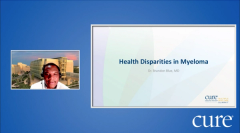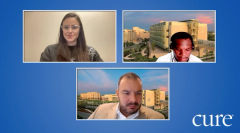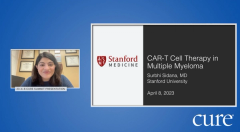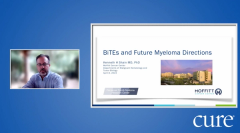
Educated Patient® Multiple Myeloma Summit CAR T-Cell Therapy Updates Presentation: April 8, 2023
Watch Dr. Surbhi Sidana, from Stanford Medicine, discuss CAR-T cell therapy during the CURE Educated Patient Multiple Myeloma Summit.
Episodes in this series

While there is still no cure for multiple myeloma, CAR-T cell therapy offers patients with previously treated myeloma “unprecedented” outcomes, according to Dr. Surbhi Sidana, assistant professor of medicine at Stanford Medicine.
CAR-T cell therapy is a type of living cell therapy, Sidana explained in a talk during the CURE® Educated Patient® Multiple Myeloma Summit.
The CAR-T cell process involves taking a patient’s T cells through a procedure called aphresis, then sending them to a lab where they are engineered and grown into millions of cancer-fighting CAR-T cells. When the CAR-T cells are ready, the patient will first undergo chemotherapy to deplete the normal immune cells. Then, the CAR-T cells are infused back into the patient, where they will seek out and destroy myeloma cells.
“The patients on this trial (that led to the FDA approval) were heavily pretreated. They’ve had a median of six different types of treatment in the past, and a majority of them were triple-class refractory, where you see the historical response rate being about 30%,” Sidana said. “(With Abecma), we saw double that — 73% (of patients responded). That is quite unprecedented.”
A year later, in March 2022, the FDA approved another CAR-T cell therapy,
Looking ahead, more CAR-T cell therapies are being explored for this patient population, while researchers are also looking at the potential benefit of moving the agents up to be given sooner in the treatment plan.
While CAR-T cell therapies offer promising outcome improvements for patients with myeloma, there are side effects — which could become severe — patients should know about, namely cytokine release syndrome, neurotoxicity and infection risk, Sidana explained.
“When these CAR-T cells are growing, they release certain chemicals, which are called cytokines. And these cytokines can cause fever and low blood pressure — the term being cytokine release syndrome — and the majority of patients (taking Abecma on a clinical trial) did get cytokine release syndrome,” she said. “Mostly it was mild to moderate. Only 5% experienced severe (cytokine release syndrome).”
When chemicals released by CAR-T cell therapy go to the brain, patients may experience neurotoxicity, which, according to the National Institutes of health, happens when there is a disruption to the neurons which are used to transmit and process signals to the brain and other parts of the nervous system.
Additionally, since part of the CAR-T cell process is suppressing the immune system, patients undergoing the treatment are at a higher risk for infection.
“It’s important to note that while blood counts do go down, many patients recovered by one month,” Sidana said. “But several patients did require ongoing blood count support even beyond a month. And that’s important because typically for a month, patients are managed at the CAR-T center, then after a month, people who live far away from a CAR-T center go back home and work with their local hematologist.”
While treatment of these side effects has improved recently, looking forward, more work still needs to be done to focus on quality of life for this patient population, Sidana said.
“We’re beginning to understand the quality of life and symptoms after CAR-T cell therapy, but much more work needs to be done so that our patients can enjoy a wonderful quality of life after (treatment with) CAR-T,” Sidana said.
For more news on cancer updates, research and education, don’t forget to














